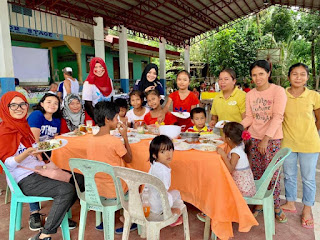The
program on Malnutrition is really challenging. There were many strategies
needed to come up in order to achieve the objectives. This is a program that
needs inter-sectoral collaboration to realize its goals. There were continuous
assessments of the children’s weights and heights to determine if they are
still part of the program.
 This
was a challenge because the team had to weigh every child 5 years old and below
in the barangay to determine their nutrition status. Another challenge is when
a child who is still malnourished but is no longer 5 years old, he/she
graduates from the program and is no longer monitored by the barangay nutrition
scholar. This gave the team different sets of data every community exposure
that needed to be analyzed and monitored once again.
This
was a challenge because the team had to weigh every child 5 years old and below
in the barangay to determine their nutrition status. Another challenge is when
a child who is still malnourished but is no longer 5 years old, he/she
graduates from the program and is no longer monitored by the barangay nutrition
scholar. This gave the team different sets of data every community exposure
that needed to be analyzed and monitored once again.
Series of health
education were also needed to increase the knowledge of community residents
regarding proper nutrition. Mothers’ classes were also done to reiterate the
importance of breastfeeding and well-balanced meal among primary caregivers.
The children, who are the main subject of this program, are also given series
of lectures, activities, and film viewings regarding proper nutrition and
healthy food choices.
Since poverty is a
problem in every community, ways on providing alternative food sources and
income-generating activities were done. Communal and backyard vegetable
gardening were established as sources of nutritious and cheap food in the
barangay. Seminars and trainings were also conducted to enhance the skills of
community residents for income-generating activities. Squash pancit canton
making was promoted to generate more income in the community.
 Feeding is of great
importance since the goal of this program is to improve the nutritional status
among undernourished children. Thus, to look for sources of funding was a
challenge. Feeding programs are also not sustainable due to lack of funding,
thus, they only last for a short period of time. Children who were able to
achieve their normal weights during the feeding might return to being
undernourished after the program. Thus, their primary caregivers need to be
continuously informed of their responsibility in maintaining their children’s
optimal nutritional status.
Feeding is of great
importance since the goal of this program is to improve the nutritional status
among undernourished children. Thus, to look for sources of funding was a
challenge. Feeding programs are also not sustainable due to lack of funding,
thus, they only last for a short period of time. Children who were able to
achieve their normal weights during the feeding might return to being
undernourished after the program. Thus, their primary caregivers need to be
continuously informed of their responsibility in maintaining their children’s
optimal nutritional status.The team’s recommendation for future comprehensive health plans on malnutrition is to come up for more sustainable projects starting second community exposure for medical students. This will allow for greater time in planning, looking for sources of funds and constructing projects. Project schemes and ordinances should also be formulated early during community exposures for better program monitoring. Revisions can also be done early on when problems arise.























